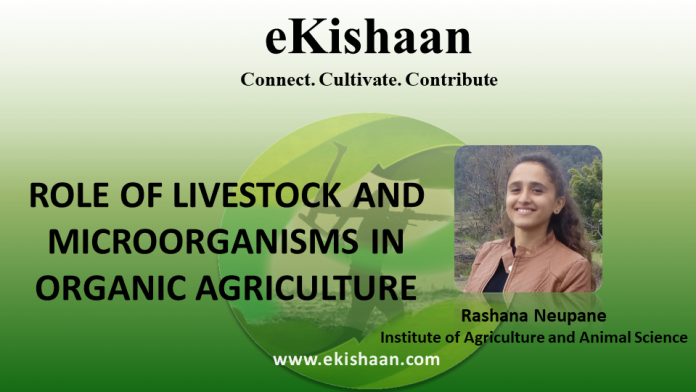ROLE OF LIVESTOCK AND MICROORGANISMS IN ORGANIC AGRICULTURE
Organic farming is a production system based on renewal of ecological process and strengthening of ecological processes and strengthening of ecological functions of farm ecosystems to produce safe and healthy food sustainability. It avoids or largely excludes the use of synthetically compounded fertilizers, pesticides, growth regulators, and livestock food additives. The aim of organic agriculture, also known as ecological or biological agriculture is to create integrated, humane, environmentally and economically viable agriculture systems in which maximum reliance is placed on locally or farm derived renewable resources and the management of ecological and biological process. The term organic is best thought of as referring not to the type of inputs used, but to the concept of the farm as an organism in which the component parts the soil minerals, organic matter, microorganisms, insects, plants, animals, and stable whole.
The micro-organisms residing on soil includes bacteria, actinomycetes, algae, and fungi which assist the organic farmer in producing a healthy crop and maintain the soil ecosystem. Many of these micro-organisms show potential biocontrol activities against weeds, crop diseases, and pests, while rhizobacteria and mycorrhizal species play role in sustainable fertility management. Microorganisms are currently being used as a replacement for synthetic pesticides and fertilizers to different crops. The mycorrhizal microorganisms protect the plant by the formation of physical barrier to the invading pathogen, secretion of antagonistic chemicals, competition with the pathogen, increase in nutrient uptake ability of plant roots and by changing the amount and type of root exudates and it also increase the uptake of phosphorous by the plants. The nitrogen fixing microorganisms in the soil increase the amount of nitrogen in the soil
Integrating livestock component into crop is one of the principles of organic farming. It plays an important role in the recycling of the nutrients. They can upgrade crop productivity by heightening supplement and nutrient based energy cycles. Those animals provide draft power along with providing manure to the farm, fuel and fertilizers and animal products such as meat, milk, egg, which provide nutrition to farmers. The by-products like rice husk, oil cakes, straw, leftovers of the kitchen, farm-by- products can be used as a feed of animals otherwise it is a waste. Bone meal, fish meal, and other by-products can also be used as an animal feed. These livestock helps in the effective recycling of the nutrients. The nutrients which are absorbed by the plants are consumed by animals and again come back to soil through dung and urine otherwise it would have been lost due to leaching. When animals consume vegetation and produce dung, nutrients are recycled more quickly than when the vegetation decays naturally.
Grazing livestock transfer nutrients from range to cropland and concentrate on selected areas of the farm. Animals transform plant energy into useful work. Animal power is used for ploughing, transport, and in activities like milling, logging, road construction, marketing, and water lifting for irrigation. The manure itself contains 8 kg nitrogen, 4 kg phosphorous, and 16 kg of potassium in a ton. Adding manure not only fertilizes soil but also improve structure and water retention. Farm animals are utilized widely for weed control on natural farming. They graze down weeds either before or after crop establishment. They can help with stubble management by brushing and trampling the stubble. These also helps in insect and disease control and preparation of land for cropping.
Hence, microorganisms and Animals component are very important in organic agriculture. In a country like ours, being landlocked and economically poor organic agriculture is the best alternative to conventional agriculture. Time to time blockade of the borders and high price of the raw material along with untimely availability of the inputs has created many problems in agriculture sector. So the one and only alternative for this is the adoption of organic agriculture for which animal component share the inputs for production.
